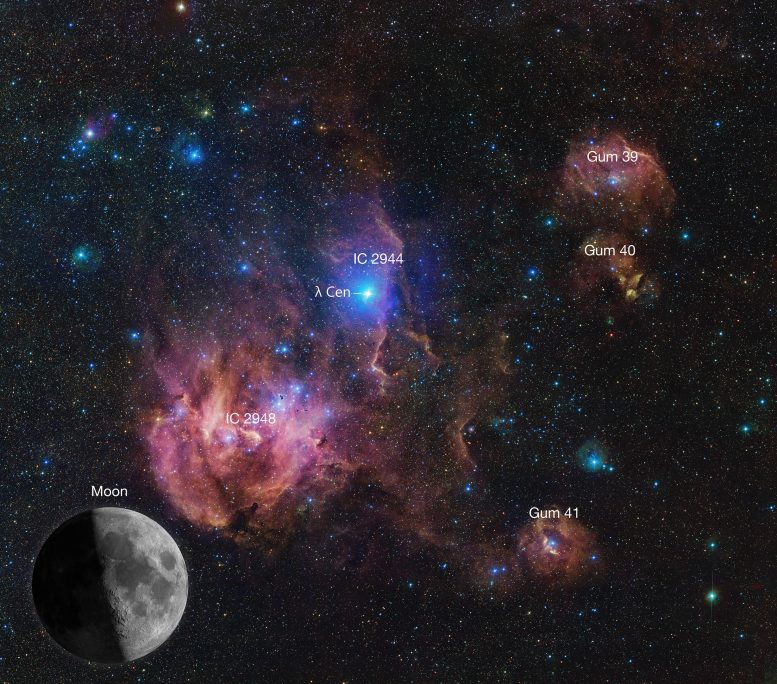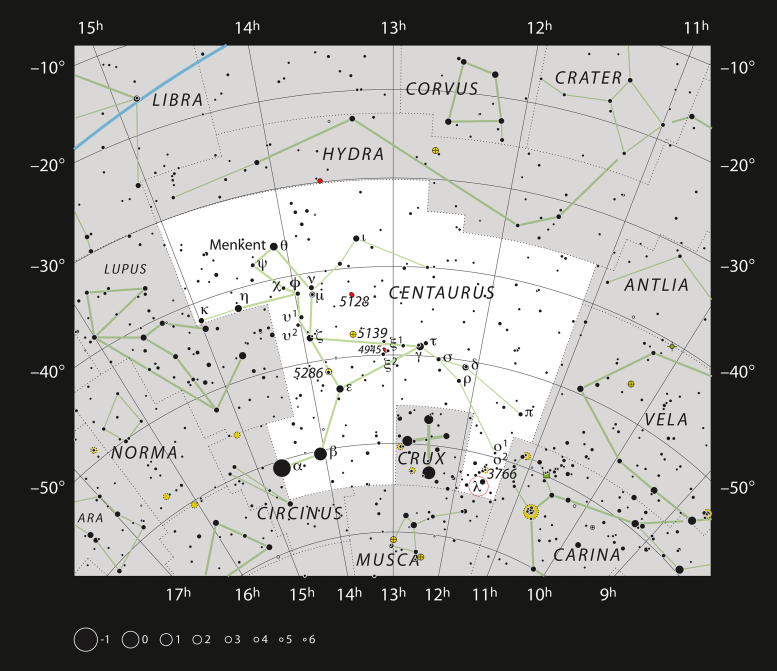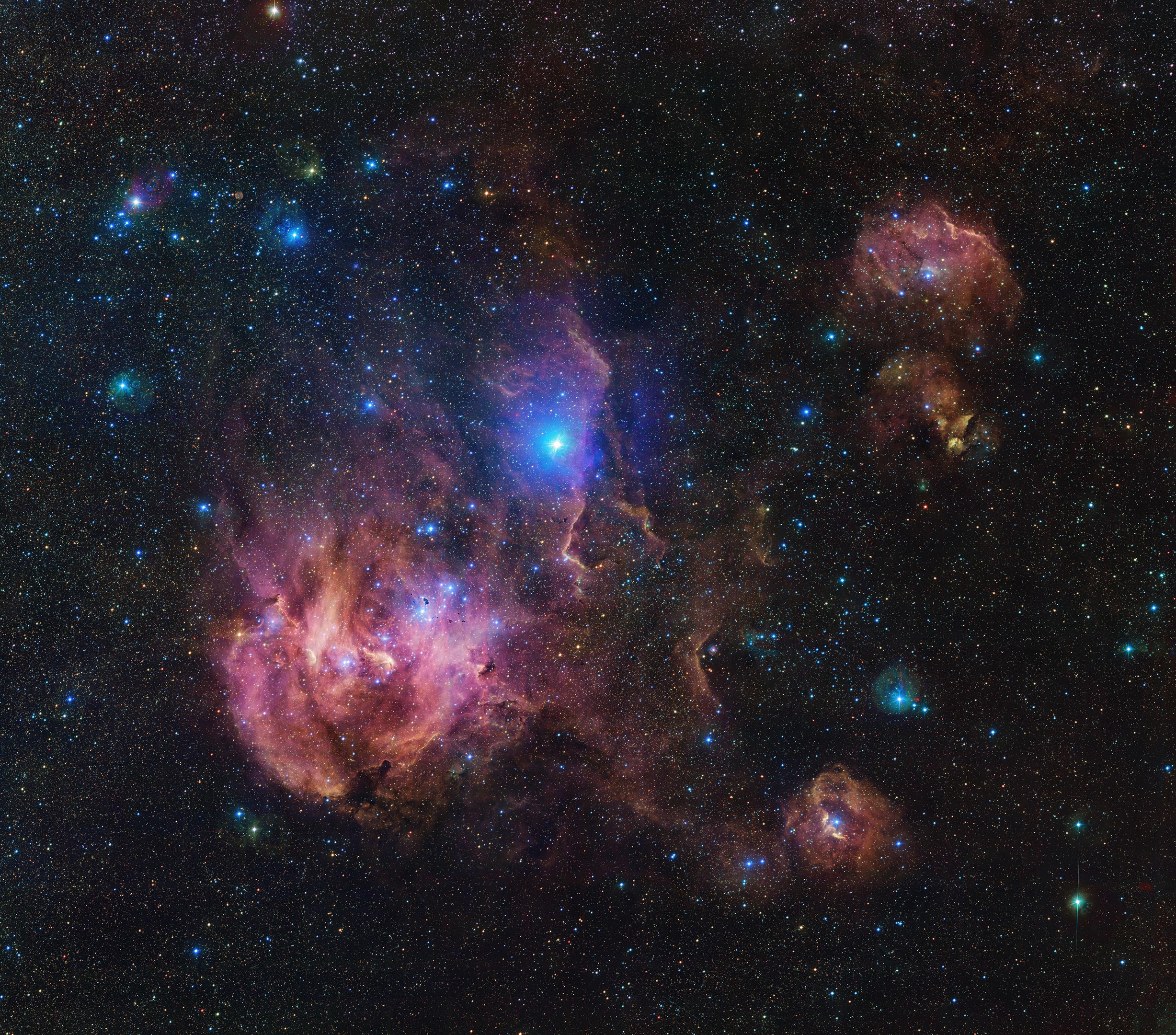The Running Chicken Nebula comprises several clouds, all of which we can see in this vast image from the VLT Survey Telescope (VST), hosted at ESO’s Paranal site. This 1.5-billion-pixel image spans an area in the sky of about 25 full Moons. The clouds shown in wispy pink plumes are full of gas and dust, illuminated by the young and hot stars within them. Credit: ESO/VPHAS+ team. Acknowledgment: CASU
The ESO unveils a detailed image of the Running Chicken Nebula, located 6500 light-years away in the Centaurus constellation. This 1.5-billion-pixel image, captured by the VST, highlights young stars and regions like IC 2948 and IC 2944, offering a cosmic feast for the eyes.
While many holiday traditions involve feasts of turkey, soba noodles, latkes, or Pan de Pascua, this year, the European Southern Observatory (ESO) is bringing you a holiday chicken. The so-called Running Chicken Nebula, home to young stars in the making, is revealed in spectacular detail in this 1.5-billion-pixel image captured by the VLT Survey Telescope (VST), hosted at ESO’s Paranal site in Chile.
This vast stellar nursery is located in the constellation Centaurus (the Centaur), at about 6500 light-years from Earth. Young stars within this nebula emit intense radiation that makes the surrounding hydrogen gas glow in shades of pink.
The Running Chicken Nebula actually comprises several regions, all of which we can see in this vast image that spans an area in the sky of about 25 full Moons.[1] The brightest region within the nebula is called IC 2948, where some people see the chicken’s head and others its rear end. The wispy pastel contours are ethereal plumes of gas and dust. Towards the center of the image, marked by the bright, vertical, almost pillar-like, structure, is IC 2944. The brightest twinkle in this particular region is Lambda Centauri, a star visible to the naked eye that is much closer to us than the nebula itself.

The Running Chicken Nebula comprises several clouds, the most prominent of which are labeled in this vast image from the VLT Survey Telescope (VST), hosted at ESO’s Paranal site. The bright star labeled Lambda Centauri is actually much closer to us than the nebula itself, and can be seen with the naked eye. The clouds shown in wispy pink plumes are full of gas and dust, illuminated by the young and hot stars within them. Overall, this image spans an area in the sky of about 25 full Moons, one of which is shown to scale for reference. Credit: ESO/VPHAS+ team. Acknowledgment: CASU
There are, however, many young stars within IC 2948 and IC 2944 themselves — and while they might be bright, they’re most certainly not merry. As they spit out vast amounts of radiation, they carve up their environment much like, well, a chicken. Some regions of the nebula, known as Bok globules, can withstand the fierce bombardment from the ultraviolet radiation pervading this region. If you zoom in to the image, you might see them: small, dark, and dense pockets of dust and gas dotted across the nebula.
Other regions pictured here include, to the upper right, Gum 39 and 40, and to the lower right, Gum 41. Aside from nebulae, there are countless orange, white, and blue stars, like fireworks in the sky. Overall in this image, there are more wonders than can be described — zoom in and pan across, and you’ll have a feast for the eyes.
This 3D animation of the Running Chicken Nebula imagines what it might feel like to fly close to these swirling clouds of gas and dust. This video is based on a real image from the VLT Survey Telescope, hosted at ESO’s Paranal site; however, the 3D location of the stars shown here is only indicative. Credit: ESO/VPHAS+ team. Acknowledgment: CASU
This image is a large mosaic comprising hundreds of separate frames carefully stitched together. The individual images were taken through filters that let through light of different colors, which were then combined into the final result presented here. The observations were conducted with the wide-field camera OmegaCAM on the VST, a telescope owned by the National Institute for Astrophysics in Italy (INAF) and hosted by ESO at its Paranal site in Chile’s Atacama Desert that is ideally suited for mapping the southern sky in visible light. The data that went into making this mosaic were taken as part of the VST Photometric Hα Survey of the Southern Galactic Plane and Bulge (VPHAS+), a project aimed at better understanding the life cycle of stars.

This chart shows the location of the Running Chicken Nebula (IC2944) in the large southern constellation of Centaurus (The Centaur). This map shows most of the stars visible to the unaided eye under good conditions and the location of the nebula itself is marked with a red circle. Although the star cluster IC 2948, associated with this nebula, is easily seen in a small telescope, the nebula is very faint and was only discovered photographically early in the 20th century. Credit: ESO, IAU and Sky & Telescope
Notes
- This image, edge to edge, is 270 light-years wide. It would take an average chicken almost 21 billion years to run across it. That’s much longer than our Universe has been around for.
Access the full-size 3.9 GB image here.

Dr. Thomas Hughes is a UK-based scientist and science communicator who makes complex topics accessible to readers. His articles explore breakthroughs in various scientific disciplines, from space exploration to cutting-edge research.








